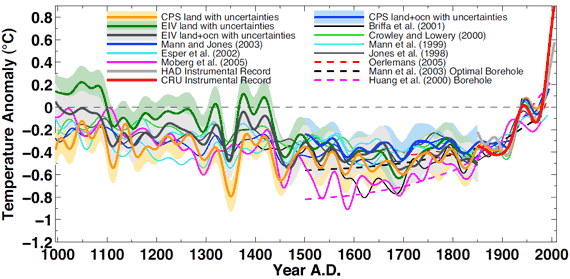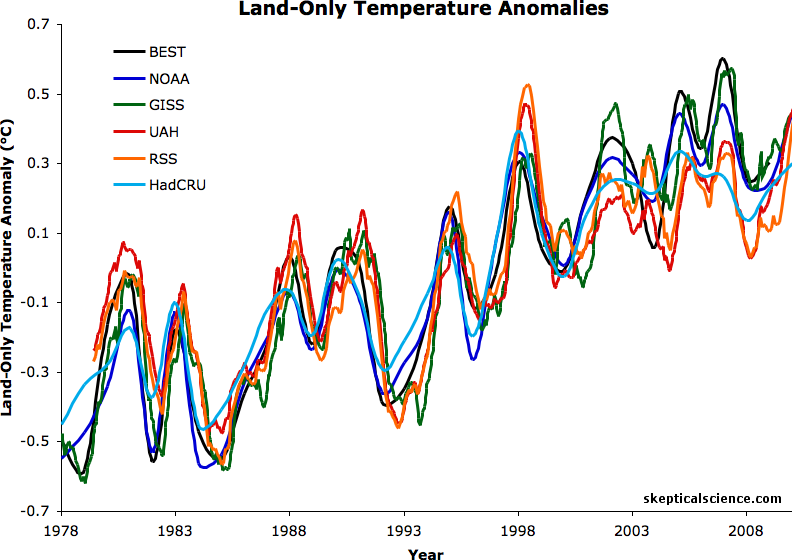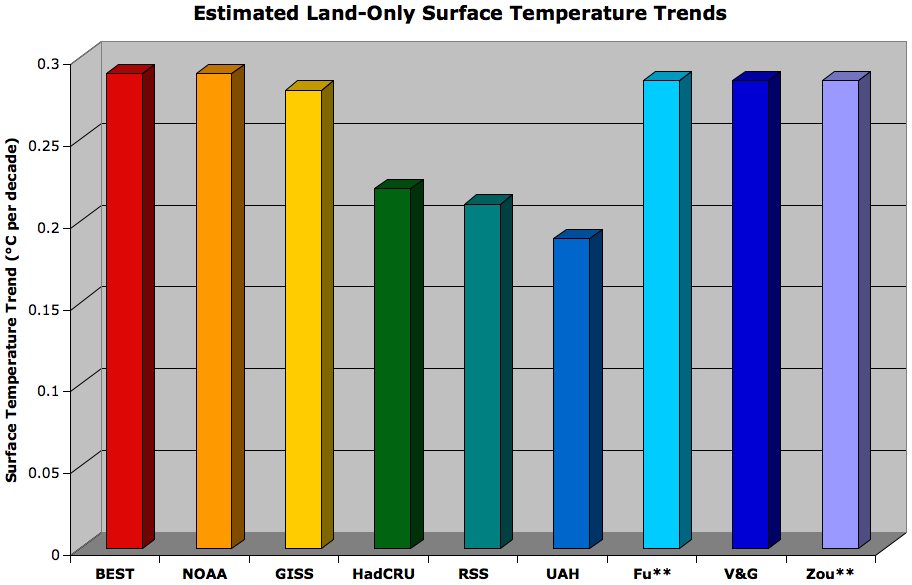Eschenbach and McIntyre's BEST Shot at the Surface Temperature Record
Posted on 6 November 2011 by dana1981, Rob Honeycutt, Kevin C, Glenn Tamblyn
Despite all the scientific evidence and peer-reviewed research confirming the accuracy of the surface temperature record, climate "skeptics" have long disputed its accuracy based on little more than some pretty pictures. We had hoped that the Berkeley Earth Surface Temperature (BEST) project, funded by private groups like the Koch Brothers, run by skeptics like Muller and Curry, and whose results "skeptics" like Anthony Watts promised to accept, would end the denial of the surface temperature record accuracy. Alas, it has not.
Hungry "Skeptics"
At "skeptic" blogs WUWT and Climate Audit, Willis Eschenbach and Steve McIntyre have chosen to take on the BEST data in analyses of their own, the former of which leaves one wondering about Eschenbach's choice of restaurants. He suggests that the analysis of the BEST data, like a Hollywood Chinese restaurant, leaves one hungry an hour later for stardom. Maybe we need to put the SkS Iron Chefs to the task to help satiate his hunger pangs.
First, Willis presents a chart of the unfiltered data from the BEST data and makes the suggestion that the 95% confidence intervals somehow suggests that it "might" have been warmer in the early 1800s than today.
"I don’t know about you, but Figure 1 immediately made me think of the repeated claim by Michael Mann that the temperatures of the 1990s were the warmest in a thousand years."
Apparently Willis neglected to view the video that goes along with the BEST temperature record that shows clearly that the data coming from the first half of the 1800s was sparse and limited to Europe and the eastern half of the USA.
Millenial temperature reconstructions, which universally agree that current temperatures are much hotter than during the early 19th Century, are based on much more data. Perhaps we should remind Eschenbach what Dr. Mann's "repeated claim" is based on (Figure 1).

Figure 1: Various northern hemisphere temperature reconstructions (Mann et al 2008).
Satellites vs. Surface Stations
Eschenbach then concocts a figure comparing what he calls "land-only" temperature data for satellites (UAH and RSS) and surface stations (BEST, GISS, NOAA, CRUTemp; although his GISS plot is incorrect, as we will discuss below) in an attempt to argue that the surface records are all biased by the urban heat island (UHI) effect (Figure 2).
"If there were no UHI, then (per the generally accepted theories) the atmosphere should be warming more than the ground. If there is UHI, on the other hand, the ground station records would have an upwards bias and might even indicate more warming than the atmosphere....The land temperatures are rising faster than the atmospheric temperatures, contrary to theory. In addition, the BEST data is the worst of the lot in this regard....My conclusion? We still have not resolved the UHI issue, in any of the land datasets. I’m happy to discuss other alternative explanations for what we find in Figure 3. I just can’t think of too many."

Figure 2: Eschenbach's comparison of surface and satellite land-only temperature data
Eschenbach can't think of any other explanation besides UHI contamination? This issue has already been addressed eight ways to Sunday (Peterson et al. 2003, Fall et al. 2011 [which includes Watts as a co-author!], Muller et al. 2011, Menne et al. 2010, etc.), and every time the conclusion has been that UHI and surface station siting do not affect temperature trends. McIntyre makes the same argument, and suffers from much the same satellite tunnel vision:
"I’ve divided the satellite trends by 1.4 (relying on models here) to obtain “downscaled” surface trends. Both Lindzen and (say) Gavin Schmidt agree that tropospheric trends are necessarily higher than surface trends simply though properties of the moist adiabat...
If one takes the view that downscaled satellite trends provide our most accurate present knowledge of surface trends, then one has to conclude that the BEST methodological innovations (praised by realclimate) actually provide a worse estimate of surface trends than even CRU...
In my opinion, it is highly legitimate (or as at least a null hypothesis) to place greatest weight on satellite data and presume that the higher trends in CRU and BEST arise from combinations of urbanization, changed land use, station quality, Mennian methodology etc."
But we can endeavor to cook up another pot of this stew since there are a few ingredients that these "skeptics" seem to have missed.
Correcting the Many "Skeptic" Errors
First, Eschenbach chooses a short 5-year baseline to compare the data. Secondly, he plots GISS met station temperatures without applying a land mask, which is incorrect, as Zeke quickly determined by contacting Dr. Ruedy at NASA GISS:
"GISTemp doesn’t really attempt to model land-only temperatures. Rather, the table in question is an approximation of global temperatures using only land stations. This means that it is -not- weighted proportionate to the land area in each hemisphere."
In short, Eschenbach's representation of GISS land-only temperatures is wrong, as is not surprising, since in Figure 2 it's below HadCRUT, which we know is biased low. That's a rather obvious red flag. We have reproduced Eschenbach's figure, but used a longer baseline (1981 to 2010, because Eschenbach's 5-year baseline results in a visual exaggeration of the disparity between data sets), and used correct land-only data provided to the BEST team by GISS (Figure 3).
Figure 3: As in Figure 2, but with a 1981-2010 baseline. Annual data is plotted for BEST, NOAA, and HadCRU, while a 12-month running average is plotted for the GISS, UAH, and RSS.
Clearly our analysis produces significantly different results than Eschenbach's. The resulting trends (1979 to Present) are shown in Table 1.
Table 1: Land-Only Trends (1979-Present)
| Group | Land-Only Trend (°C/decade) |
| BEST | 0.29 |
| NOAA | 0.29 |
| GISS | 0.28 |
| HadCRU | 0.22 |
| RSS | 0.20 |
| UAH | 0.18 |
So, we do see a difference between surface and satellite trends. A number of studies have examined this discrepancy, with the "skeptics" (often led by John Christy) usually arguing, like Eschenbach and McIntyre, that this suggests the surface stations are biased high. When Klotzbach et al. (2009) investigated the issue, Gavin Schmidt pointed out that they had the land-only surface-atmosphere amplification factor wrong, as do both Eschenbach and McIntyre here:
The land-only ‘amplification’ factor was actually close to 0.95 (+/-0.07, 95% uncertainty in an individual simulation arising from fitting a linear trend), implying that you should be expecting that land surface temperatures to rise (slightly) faster than the satellite values.
Although Eschenbach and McIntyre have the amplification factor wrong (McIntyre later corrected his post when informed of the error by Gavin Schmidt), it should still be close to 0.95 according to climate models, but here we see it's approximately 0.7 (excluding the HadCRUT outlier). Are the "skeptics" right - does this mean BEST and the other surface temperature records are still biased high by the UHI effect?
Plausible Explanations
The short answer is no, given how much research has gone into the UHI effect, Eschenbach and McIntyre have probably chosen the least likely explanation for the discrepancy. Santer et al. (2005) offered some other possible explanations. Some of the difference may be due to the spatial coverage differences between the satellite and surface temperature data. Perhaps the discrepancy is due to natural internal variability and/or external forcings. Or perhaps it is a problem with the data, but the problem could very well lie with the tropospheric temperature measurements.
Lower Troposphere Temperatures
Measuring the temperature of the lower troposphere is a tricky task. There is no microwave sounding unit sensor for the lower troposphere; instead it's a "synthetic" channel that uses additional processing of the data from the mid-troposphere temperature (TMT) readings to try and isolate a signal from mainly the lower troposphere. The TMT channel is also influenced by the stratospheric temperatures, which are cooling.
Eschenbach and McIntyre seem unaware that there are three other groups besides UAH and RSS which analyse atmospheric temperature data. Fu et al., Vinnikov & Grody (V&G), and Zou et al. have all published research describing alternative methods to analyze the data. Their results for TMT and TLT, where available, are shown in Table 2. Fu and Zou et al. only estimate TMT trends, so we have come up with our own approximation of what their TLT estimates would look like. Note that although the V&G analysis only extends to 2004, the UAH TLT trend since 2004 is actually slightly higher than 1979-2004, so it should be safe to assume that the V&G estimated TLT trend of 0.20°C per decade applies to Present reasonably accurately.
Table 2: TLT and TMT estimates from various groups
| Group |
TMT Trend |
TLT Trend (°C/decade) |
| UAH | 0.05 | 0.14 |
| RSS | 0.087 | 0.14 |
| Fu et al. |
0.13 | ~0.2** |
| V & G |
-- |
0.20 |
| Zou et al. |
0.131 | ~0.2** |
** SkS estimate
In short, while UAH and RSS are in agreement regarding the long-term TLT trend, the other three groups are in agreement that it's significantly higher, which would mean that the amplification factor discrepancy is much smaller. In fact, if we assume a linear scaling of land-only trend ratios to global trend ratios (a factor of approximately 1.4 for UAH and RSS), the Fu, V&G, and Zou analyses would result in a land-only TLT trend of ~0.27°C per decade, which gives a scaling ratio of ~0.94 - well within the 0.95 +/- 0.07 range predicted by climate models (Figure 4).
Figure 4: Comparison of various measurements of the land-only global surface temperature. The Fu, V&G, and Zou values are estimated by SkS, and the 0.95 amplification "upscaling" factor has been incorporated into the satellite trends to estimate the surface trend.
These are very rough back-of the-envelope estimates for the Fu and Zou trends (for more details on the various tropospheric temperature estimates, see this post by Glenn), but the point is that they represent another plausible explanation for the TLT-surface discrepancy; much more plausible than the only explanation considered by Eschenbach and McIntyre.
Plausible Deniability
Frankly, the "skeptics" almost universally seem all too eager to assume that the UAH and RSS analyses are perfect and the surface temperature analyses are biased high. Based on the analyses of Fu, V&G, and Zou, an unbiased assessment would indicate the far more plausible explanation is that RSS and UAH are biased low, particularly since the accuracy of the surface temperature record has been confirmed time and time again, even by those (i.e. Anthony Watts) who have been disputing its accuracy for years. At this point, it's hard to describe the continued attempts to dispute the surface temperature record accuracy as anything other than desperation and denial.































 Arguments
Arguments

























 0
0  0
0 Using that data the slope from 1979-01 to 2009-12 is 0.274C/decade (0.277C/decade to 2010-12), bringing it much closer to BEST.
(It's still a mystery that we can't reproduce this result with CCC, but there's probably a simple answer).
Using that data the slope from 1979-01 to 2009-12 is 0.274C/decade (0.277C/decade to 2010-12), bringing it much closer to BEST.
(It's still a mystery that we can't reproduce this result with CCC, but there's probably a simple answer).







Comments